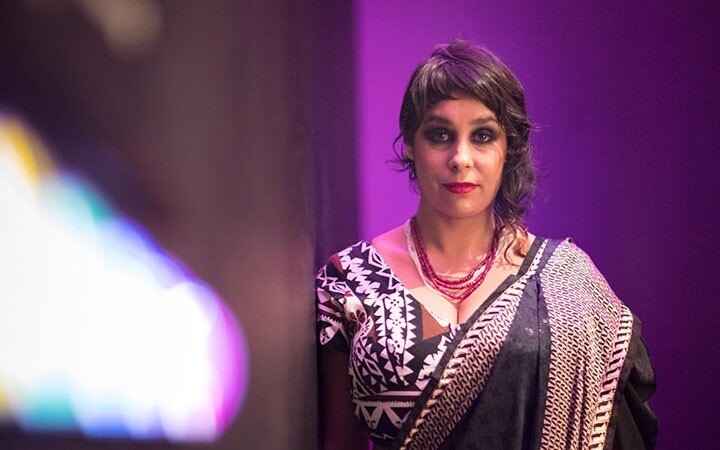Meet Tiffany Singh: re-contextualising identities through Arts

Tiffany Singh is an artist of Indian and Pacific descent. She grew up in Northcote, Auckland has graduated from Elam School of Fine Arts in 2008. Singh then spent three years in India, absorbing the culture and art of the country. Since then, Singh has exhibited extensively all over New Zealand, Australia, USA, East Asia and India. She has had residencies in USA, India, Samoa, Taiwan, Thailand and Nepal.
Singh has also won many awards and is now a part of the first contemporary Indian art exhibition in NZ called 'A Place to Stand: Contemporary Indian Art in Aotearoa' by Kshetra Collectives. Curated by some of the most distinguished Kiwi-India artists, this collaborative show explores the question What is contemporary New Zealand Indian art? The exhibition runs 15 May – 24 July at Tamaki Paenga Hira Auckland War Memorial Museum.
We sat down with Tiffany Singh and asked her about her art, her style and her influences:
Tell us something about your roots, education and upbringing
I was born in Aotearoa of Indian and Pacific descent, and my work explores a blending of these cultural identities; as descended from my great grandfather, who immigrated to Fiji during the girmit in the late 1800s and my Pacific ethnicity as descended from Seumanutafa Puaaefu, Paramount Chief of Apia Samoa in the late 1800s, my great great grandfather.
My arts practice explores the intersection between arts, education, and wellbeing. I graduated Elam School of Fine Art with a BFA (hons) in 2008, and have worked on sustainable community outreach, exploring engagement in the arts through social practice methodology ever since.
What have been some of the significant influences that have shaped your style?
Social practice or socially engaged practice is an art medium that focuses on engagement through human interaction and social discourse. This art form has been a major influence on not only what I make, but also how I make and the collaborative processes that go with this. This has positioned a practice as a vehicle to engender policy and advocacy of social justice. As many of my projects mobilise the strength of small artisan communities for stronger socio-economic development at local and international levels.
What do you hope to convey or express through your art?
The most important thing for me is to collect commentaries from a cross section of landscapes to emphasise the power of collaboration. With the focus of repositioning the arts and their importance to well-being & education.
Do you dabble in different forms and mediums, and what is your preferred medium?
I don't dabble in anything. I am a professional installation artist. Three-dimensional space is where my skill set is honed.
In what way have your roots and origin impacted your art?
Acknowledging my forefathers & foremothers is a start point to develop a sense of place and belonging. This is applied to a cultural, physical and spiritual enquiry which evolves from ongoing research into the ancestors & their ancient belief systems.
Any Indian style of art or painting that you admire?
I have multiple Indian women artists who are a source of inspiration to me—Shilpa Gupta, Hema Upadhyay and Reena Saini Kallat to name a few. But closer to home and women that I have worked with, Anitha N Ready and Indu Anthony and Mandrika Rupa are pushing things in new directions and bringing light to previously unseen and heard narratives.
Have you ever exhibited your work in India? Tell us about the experience.
I had a residency in India granted through the Asian NZ foundation in 2012. I exhibited at #No1 Shanti Road, Bangalore. I love India. It feels like home to me. Every time I am there, it opens my mind and heart to new creative possibilities.
What will be your message for the budding ethnic artists?
Well, we are all ethnic of some description, so I am unsure if that is the right terminology, but what I would say to migrant artists and artists of mixed-race is don't give up or feel disheartened. If you feel misunderstood, use that as a driver to go deeper into your enquiry and see the process as a space of healing and wellbeing to explore the experiences in depth. Use your practice as a space to educate others about your experience or create a space that others can identify with and learn from.
Tell us about your latest exhibition
The artists of the Kshetra Collective embody a range of the Indian diaspora and its diversity. The collective aims to be inclusive of artists and creatives rather than focusing on a specific group, religion or language. This is the first group show of its kind in Aotearoa and is of great significance, especially for communities and audiences that have had little representation in respected New Zealand institutions.
My collaboration with Mandrika Rupa aims to illuminate alternative histories, re-contextualising national identities, especially immigrants of Indian descent, in new lands. Here both artists consider their cultural artistic practice to be their own subjective truth to further the narrative around migration. The manipulation of materials and content draws from these artisan lineages. Resulting in Remnant, an installation developed out of both artists' personal need to explore the social implications of immigrant communities and the effects ethnicity has on this process.





